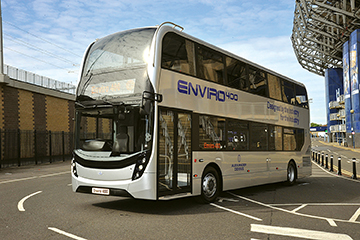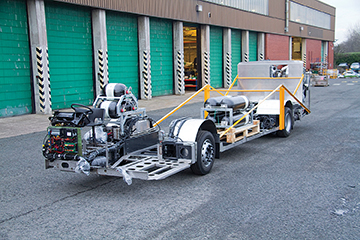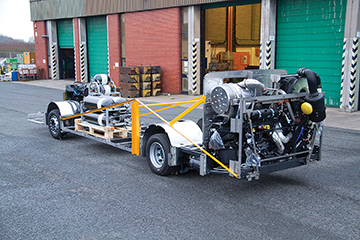

Scania develops double-decker gas bus
n our industry, we must always be wary about describing any development as a world first, but Scania recently unveiled a double-decker city bus chassis fueled by compressed natural gas (CNG). I recall very old photographs from the World War II showing double-decker buses with trailers that produced the natural gas, but the latest Scania is almost certainly a modern first.
Scania has its headquarters in Södertälje, Sweden, one half-hour south of Stockholm. The company builds a range of medium and heavy trucks through a very clever permutation of a relatively small number of parts. It also builds a range of city bus, interurban, charter and express coaches using some of the truck engines and truck transmissions in some models.
The company’s degree of control over the creation of new parts is legendary, and a great benefit. For instance, Scania builds a range of five, six and eight-cylinder engines that all use one common piston. This not only helps to keep tight control on production costs, but greatly simplifies parts and service support. In most markets, select authorized truck dealers provide support for buses and coaches.
Scania has developed some of its engines to run on alternative fuels over the last two decades at least. It has promoted ethanol, principally in Sweden, with more than 800 buses running in Stockholm. In Sweden, there is an extensive forestry industry where ethanol is produced from the sap of felled trees. More recently, Scania has tried to promote ethanol in tropical countries where the fuel can be produced from renewable crops.
Scania also reckons to have built more than 4,000 gas engines in the last 20 years, for buses, trucks and industrial applications, with around half the output installed in buses. In Scandinavian markets, CNG and biogas are popular on political and environmental grounds. An engine running on CNG produces 10-20 percent less CO2 than the latest and cleanest Euro 6 diesel engines. On biogas engines, a reduction in CO2 emissions can be as much as 90 percent.
Compared to other European markets, the United Kingdom has been slow to adopt gas as an alternative fuel to diesel. However, Scania worked with Alexander Dennis Limited (ADL) to supply around 80 CNG-fueled buses to two customers in the last two to three years – and they have proved popular and reliable. The aluminium-framed bodywork was built by Alexander Dennis at is factory in Falkirk, Scotland, and the roof-mounted gas tanks were neatly concealed by shrouds.
Two of the reasons for resistance to gas-fueled buses have been the cost of providing a refueling infrastructure and the risk of being tied into long-term supply contracts. However, Scania has found a partner who is willing to supply the installations, freeing customers to shop around for the best fuel prices.
Another concern has been the risk of lower residual values, particularly on vehicles bought for fixed-term contracts. The latest Scania CNG engine can similarly run on liquefied natural gas (LNG) which is simpler to store at a depot.
The two main types of transit buses in the United Kingdom are midibuses (around 12 tons gross) and double-decker buses. The latter can be found all over the country, not just in London.

The big question with a gas-fueled double-decker bus is where to locate the gas tanks. They certainly cannot be mounted at roof level. Scania had previously used a specialist contractor, mi Vehicle Integration Ltd., based in the town of Leyland in the northwest of England to assemble diesel-powered double-decker chassis.
Standard modules were supplied from Sweden and incorporated in a full low-floor underframe, designed and built by mi Vehicle Integration. The front module consisted of the front axle, steering, suspension, driver’s platform and instruments. The rear module had a transversely mounted vertical engine, gearbox, driveline, drop-center rear axle and suspension.
The chassis was built to an overall length of 37 feet, 6 inches and when bodied by Alexander, the overall height will be 14 feet, 3 inches. The bus will be built to the standard overall European legal width limit of 8 feet, 4 inches.
By working closely together, the three partners ensured that 95 percent of the components in the latest generation Enviro400 double-decker body were the same on the Scania underframe and Alexander Dennis’ own underframe with a Cummins diesel engine. This will be a major benefit in bodywork production.
The location of the gas tanks is ingenious. Three tanks with a combined capacity of nearly 772-pounds (350 kilogram) of gas were mounted, one above the other two, in a cradle over the offside front wheel so that they would fit neatly under the staircase of the completed bus. Four larger and longer tanks, each capable of holding around 320 pounds (of gas will be mounted in a stack at the rear of the upper deck, above the engine, resulting in the loss of the normal rearmost row of seats. On double-decker buses for export markets, ADL normally fits the air conditioning system above the engine and beneath the rearmost row of seats upstairs. However, air conditioning is not normally required for the British market.
The Scania ADL gas double-deckers will normally have 45 seats on the upper deck and around 28 or 29 seats on the lower deck, depending on the number of standing passengers. Although there is a weight penalty with gas tanks, it will probably be only around 600 pounds compared with a standard diesel vehicle to a similar specification. Legally that might result in the loss of four to five standing passengers.
Currently, in the UK and quite a number of European countries, the maximum permitted weight of a two-axle bus is 18 tons. However, the European Commission recognizes that ultra-clean engines and alternative fuels add to the unladen weight of buses and they are proposing to increase the limit to at least 19 tons.
The partners in the project thought that the increase in price, compared with a standard Euro 6 diesel bus, would be around 20 percent, but that now looks closer to 15 percent. The performance of the latest Scania CNG engine is equivalent to its diesel engines, and maintenance is relatively simple. Because of the lower price of gas, the payback period may typically be around five years.

There are grants in the United Kingdom to help with the purchase of vehicles with ultra low emissions. Normally, these pay the difference in price compared with a standard Euro 6 diesel bus. Scania and ADL said at the launch that they had firm enquires for around 200 units. At least two major operators are believed to be well advanced in applying for grants and the first vehicle will become a demonstrator after completion.
The current price of oil and gas on world markets is lower than it has been at any time in the last 12 years. Here in Europe, we think that Saudi Arabia is hell-bent on making the fracking industry uneconomic in North America. It has, of course, also hit the price of North Sea oil in Norway and the United Kingdom.
However, that situation cannot go on forever. It is hurting the Saudi economy at a time when there are reports of succession and divisions within the ruling royal family. The lifting of sanctions against Iran, and its massive known reserves of oil, is likely to lead to further cheap supplies in the short to medium term.
However, this price cutting cannot continue forever, and the price of fossil fuels will have to rise. The Scania CNG double-decker project may therefore turn out to be inspired as a good long-term prospect.
Doug Jack is with Transport Resources in the United Kingdom.
